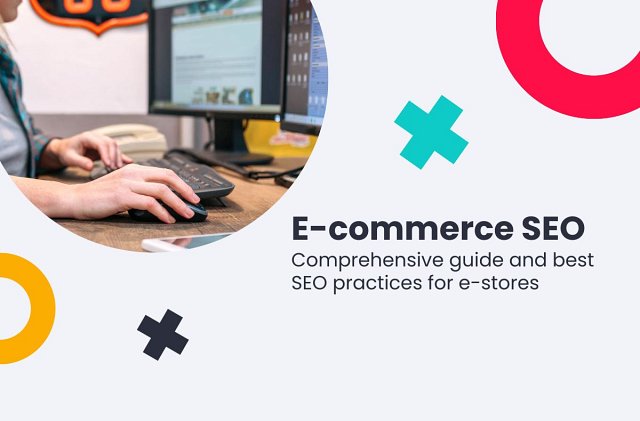(19 min. read)

Table of Contents
- What is e-commerce SEO?
- How do you increase your sales with SEO?
- Best e-commerce platforms for SEO
- How to do SEO for an e-commerce website? A Step-by-step guide
- Keyword research for E-commerce
- E-commerce site architecture
- On-page SEO for e-commerce
- Content marketing for e-commerce sites
- Technical SEO
- Link building for e-stores
- Track Your e-commerce SEO results
- E-commerce SEO tips
- E-commerce SEO checklist
What is e-commerce SEO?
Search Engine Optimization is the heart of online visibility, and it's no different for e-commerce websites. While SEO principles apply universally, optimizing an e-commerce site demands a unique approach.
E-commerce SEO enhances the visibility and ranking of an online store in search engine results. Whether you're selling handmade crafts or clothing, a strong online presence is important. Here's why E-commerce SEO matters:
- Targeted Keywords: E-commerce SEO begins with meticulous keyword research. Understanding what your potential customers are searching for is pivotal. Target long-tail keywords like "best e-commerce platform for SEO" or "SEO for e-commerce product pages" to connect with your niche audience.
- On-Page Optimization: Optimizing product pages is a cornerstone of E-commerce SEO. Craft compelling product descriptions, use high-quality images, and ensure your page loads swiftly. Don't forget to incorporate those carefully researched keywords seamlessly.
- Technical SEO: The technical health of your e-commerce site is vital. From site speed to secure transactions, these factors influence both search rankings and user experience.
- User Experience: A user-friendly interface, easy navigation, and intuitive design can keep visitors engaged and lead to higher conversion rates.
- Content Marketing: Regularly update your blog with informative, relevant, and engaging content. Share insights about your products, industry trends, and customer stories.
- Link Building: High-quality backlinks from authoritative websites can boost your site's credibility and improve search rankings.
- Analytics and Tracking: Implement tools like Google Analytics to monitor the performance of your SEO efforts. Track keyword rankings, organic traffic, and conversion rates to refine your strategies.
- Mobile Optimization: With a surge in mobile shopping, ensure that your e-commerce site is mobile-responsive for a seamless experience.
E-commerce SEO strategies. How does it differ from regular SEO?
E-commerce SEO is a specialized branch of search engine optimization tailored to the unique needs and challenges of online stores. While the core principles of SEO apply across the board, E-commerce SEO strategies must address distinct aspects that set them apart from regular SEO. In this section, we'll outline the most crucial steps in E-commerce SEO strategy and highlight what distinguishes them from traditional SEO.
1. Keyword Research:
E-commerce SEO heavily emphasizes long-tail keywords specific to products. These keywords are essential for connecting with users who are further along the purchasing journey.
2. Site Architecture:
Organizing product categories, subcategories, and ensuring clear navigation is pivotal for E-commerce SEO. An intuitive structure aids both users and search engines in finding and indexing products efficiently.
3. On-Page SEO:
On E-commerce sites, optimizing product pages is paramount. This involves crafting unique, keyword-rich product descriptions, optimizing images, and providing structured data for rich snippets in search results.
4. Content Marketing:
Content marketing in E-commerce involves creating valuable product guides, reviews, and user-generated content to aid customers in making informed purchasing decisions. It also helps in building authority and trust.
5. Technical SEO:
E-commerce sites often have complex technical requirements, including managing large product catalogs, ensuring mobile-friendliness, and securing online transactions. These technical aspects are crucial for both SEO and user experience.
6. Link Building:
E-commerce sites can benefit from building relationships with manufacturers, suppliers, and industry influencers to acquire high-quality backlinks. These connections can boost credibility and authority in the E-commerce sector.
How do you increase your sales with SEO?
Organic search, driven by SEO efforts, plays a pivotal role in increasing sales for online retailers. Let's dive into why SEO is a game-changer for e-commerce and explore some compelling data and statistics that underscore its importance.
Organic Traffic Dominance:Research consistently shows that organic search drives the majority of web traffic for e-commerce sites. According to a study by BrightEdge, organic search accounted for 53.3% of all trackable e-commerce traffic.
High Conversion Rates:Organic traffic often leads to higher conversion rates compared to other traffic sources. Visitors who arrive at your e-commerce site through relevant search queries are more likely to convert into customers. A report from BigCommerce indicates that organic search traffic has a conversion rate of 2.5%, significantly outperforming traffic from social media or email.
Long-Term Sustainability: SEO investments pay off in the long run. Unlike paid advertising, which stops driving traffic once the budget is exhausted, well-optimized content and SEO efforts continue to attract organic traffic over time. This sustained visibility is crucial for e-commerce success.
Revenue Boost: According to a study by Moz, websites that invest in SEO efforts experience an average revenue increase of 40% within the first year.
Mobile Commerce: With the surge in mobile shopping, mobile SEO is critical for e-commerce. Google reports that 61% of mobile searchers are more likely to contact a local business if they have a mobile-friendly site. Mobile optimization can significantly impact sales for online retailers.
Voice Search Potential: Voice commerce is on the rise, and SEO optimization for voice search can open up new opportunities for e-commerce. ComScore predicted that by 2022, voice shopping would reach $40 billion in the United States.
User Experience and SEO: A seamless user experience, often linked to SEO efforts, is crucial for e-commerce success. A study by Akamai found that even a one-second delay in page load time can lead to a 7% reduction in conversion rates.
Best e-commerce platforms for SEO
E-commerce platforms are the bedrock upon which online businesses thrive. These software solutions provide the infrastructure for creating, managing, and growing your online store. However, e-commerce platform choice is far more than a technical decision. It profoundly influences your website's SEO performance and overall success. Picking the right e-commerce platform is similar to choosing a home's foundation. It must be robust, adaptable, and supportive. You can see the best e-commerce platforms. Each offers unique benefits to empower your SEO strategy:
Shopify
Benefits: Shopify is known for its user-friendliness. It has customizable templates and built-in SEO tools, such as editable meta tags and automatic sitemaps.
WooCommerce (for WordPress)
Benefits: WooCommerce, as an open-source plugin for WordPress, grants you unparalleled flexibility, while SEO plugins like Yoast SEO enable fine-grained SEO control.
BigCommerce
Benefits: BigCommerce stands out with its SEO capabilities, offering customizable URLs, schema markup integration, and a suite of built-in SEO tools.
Magento
Benefits: Magento excels for large and complex catalogs, providing advanced customization options, technical SEO features, and extensive scalability.
Wix
Benefits: Wix combines user-friendly website building with essential SEO features, making it accessible for businesses looking to optimize their online presence.
Square Online
Benefits: Square Online simplifies e-commerce setup and offers sunken SEO features to boost your website's visibility and rankings.
While choosing a platform, think about your business's needs, budget, and goals.
How to do SEO for an e-commerce website? A Step-by-step guide
Optimizing an e-commerce website for search engines is akin to exploring a complex and multifaceted terrain. In this comprehensive guide, we will delve into the intricacies of E-commerce SEO, unraveling the steps that can elevate your online store's visibility and draw in potential customers.
Our exploration begins with the cornerstone of SEO – Keyword Research. Understanding how to identify and use relevant long-tail keywords specific to your products or services is the first step to connecting with your target audience. Once you've mapped out your keyword strategy, the next stage is crafting an effective Site Architecture. Organizing your e-commerce site logically, creating clear categories and subcategories, and ensuring product accessibility are vital components of this phase. Each category's descriptive page is your ticket to attracting both search engines and inquisitive shoppers.
On-page SEO is where your individual product pages come to life. Discover the art of naturally incorporating target keywords into titles, descriptions, headings, and image alt tags. We'll also emphasize the importance of crafting unique and engaging product descriptions to capture the interest of your potential customers. Enhance your search results with schema markup, providing search engines with additional information about your products, including reviews, ratings, and pricing details. This advanced technique can make your listings stand out in search engine results.
Technical SEO is the invisible hand that guides search engine crawlers through your site. Site speed, mobile-friendliness, and secure HTTPS connections all play a role in this realm. We'll show you how to create an XML sitemap and submit it to search engines for seamless indexing, ensuring your website's technical foundation is robust. In an era of mobile shopping dominance, mobile optimization is paramount. Your site works on smartphones and tablets well. Fast and technically well-optimized websites enhance user experience.
In the digital landscape, Content Marketing reigns supreme. We'll explore the significance of creating a blog or content section on your e-commerce site, where valuable, relevant content addressing user queries, product guides, and industry insights can enhance your SEO efforts and engage your audience. Link Building is the process of building a network of connections. Learn how to secure high-quality backlinks from reputable sources, understanding that quality far outweighs quantity in this endeavor. Elevating your authority within your niche is the key to long-term SEO success.
To measure your SEO success, Analytics and Monitoring tools like Google Analytics become your trusty companions. We'll show you how to track keyword rankings, monitor organic traffic, and analyze conversion rates, empowering you to refine your SEO strategies continually.
By the end of this guide, you'll be able to navigate the intricate landscape of e-commerce SEO and unlock your online store's full potential in the digital world.
Keyword research for E-commerce
Keyword research is the cornerstone of a successful E-commerce SEO strategy. It's the compass that guides you toward understanding what potential customers are searching for and how they discover products online. In this competitive digital landscape, selecting the right keywords can mean the difference between thriving and merely surviving.
Begin your journey by brainstorming a list of seed keywords directly related to your products or services. Then, employ keyword research tools like Google Keyword Planner, Semrush, or Ahrefs to expand your list. Look for long-tail keywords, which are longer and more specific phrases that often indicate a higher intent to purchase. Pay attention to search volume and competition metrics to identify the most promising keywords.
Furthermore, consider user intent. Are searchers looking for product information comparisons, or ready to make a purchase? Tailor your content and product listings accordingly. Once you've compiled a robust list of keywords, strategically integrate them into your product titles, descriptions, headings, and metadata. Regularly revisit and refine your keyword strategy to stay aligned with shifting consumer behavior and trends.
How to choose keywords for e-commerce pages?
When selecting keywords for your e-commerce pages, it's essential to understand the different types of keywords and how they align with user search intent. Two primary types of keywords are informational and transactional.
Informational Keywords: These are used by users seeking information or answers. For e-commerce, they might include phrases like "how to choose running shoes" or "best winter coat materials." While not directly related to sales, creating content around informational keywords can establish your authority and attract potential customers during their research phase.
Transactional Keywords: These keywords indicate that users are ready to make a purchase. Examples include "buy iPhone 13" or "discounted laptop deals." Targeting transactional keywords is crucial for product pages as they attract users with a clear intent to buy.
Understanding search intent is key. It determines the content of your page. For informational keywords, create blog posts, guides, or videos that provide valuable information. For transactional keywords, focus on product pages with compelling descriptions and clear calls to action.
To identify the right keywords, use keyword research tools like Google Keyword Planner, Semrush, or Ahrefs. Start with seed keywords related to your products, analyze search volume, and assess keyword difficulty. Pay attention to long-tail keywords, as they often have lower competition and are highly specific to user intent.
Additionally, study your competitors and look for keywords they are ranking for. Customer feedback and questions can also be a goldmine for keyword ideas.
E-commerce site architecture
Site architecture, often referred to as website structure, serves as the backbone of your e-commerce website. It's the organization of your web pages, content, and how they interconnect. The significance of a well-organized site architecture cannot be overstated. It directly impacts user experience, SEO, and the overall effectiveness of your online store.
A well-structured e-commerce site typically includes category pages that group related products together, making navigation intuitive for visitors. Tags and labels further enhance organization by allowing products to belong to multiple categories or themes. This flexibility aids in presenting products to potential customers from various angles.
In terms of site architecture, a good structure is characterised by logical categorisation, easy navigation, and a hierarchy that mirrors the importance and relevance of pages. In contrast, a bad website structure can cause confusion, poor user experience, and search engine problems in understanding your content. It's crucial to ensure that your site's architecture is designed with both users and search engines in mind.
On-page SEO for e-commerce
On-page SEO factors are crucial elements that directly impact how a specific webpage performs in search engine rankings. When it comes to e-commerce, on-page optimization is important in the visibility and relevance of product pages. Here's a concise breakdown of the key on-page factors that influence e-commerce pages:
URL Structure: A clean and descriptive URL structure helps both users and search engines understand the content of a page. For e-commerce, this means having URLs that include relevant keywords and product details.
Title Tag: The title tag is the first thing users see in search results. Crafting compelling and keyword-rich title tags for product pages is essential to entice clicks and improve rankings.
Metadata: Meta descriptions provide a brief overview of a page's content. For e-commerce, this is an opportunity to highlight unique selling points and include keywords to attract potential customers.
Alt Text: Alt text for images is crucial for accessibility and SEO. In e-commerce, it's essential to use descriptive alt text that includes relevant keywords to enhance the visibility of product images in search results.
Body Copy: Well-written product descriptions that incorporate keywords naturally are essential for on-page SEO in e-commerce. Informative and engaging content can also influence user engagement and conversion rates.
Internal Links: Linking related products or pages can improve user navigation and distribute link authority across your site, ultimately enhancing SEO for e-commerce websites.
Content marketing for e-commerce sites
Content marketing plays a pivotal role in strengthening an e-commerce SEO strategy. It goes beyond product listings and delves into creating valuable, informative, and engaging content that attracts and retains customers. Here's how content marketing contributes to e-commerce SEO:
Blog Posts: Publishing blog posts related to your products, industry trends, and customer stories not only provides valuable information but also helps you target long-tail keywords, improving your search engine rankings.
Digital PR Campaigns: Collaborating with influencers and industry experts or running digital PR campaigns can garner backlinks from reputable sources, enhancing your site's authority in the eyes of search engines.
Social Media: Sharing blog posts, product updates, and user-generated content on social media platforms can attract traffic to your e-commerce site and improve brand visibility, indirectly benefiting SEO.
Video Content: Video content, such as product demos, tutorials, or customer testimonials, keeps users on your site longer. This can positively impact SEO rankings.
For example, let's consider an e-commerce store selling eco-friendly home products. They could launch a content marketing campaign centered around "Sustainability Tips for a Greener Home." This campaign might include a series of blog posts, a video showcasing their products in action, and a digital PR effort featuring collaborations with eco-conscious influencers. This holistic approach not only provides valuable information to their audience but also aligns with their brand values, attracting both customers and search engines.
Technical SEO
Technical SEO involves optimizing the technical aspects of a website to improve its visibility and performance on search engines. When applied to e-commerce websites, technical SEO can significantly influence rankings, user experience, and ultimately, sales. Here are key technical factors that impact e-commerce SEO:
Page Speed: Faster loading pages enhance user experience and are favored by search engines. Compress images, leverage browser caching, and use content delivery networks (CDNs) to improve page speed.
Redirects: Proper handling of redirects is essential to maintain SEO equity when URLs change. Implement 301 redirects for permanent changes and 302 redirects for temporary ones.
Structured Data: Adding structured data (schema markup) to product pages can enhance search results with rich snippets, such as ratings and pricing information.
HTTPs: Secure your e-commerce site with HTTPS to build trust and ensure data security. Google also favors secure sites in its rankings.
Mobile-Friendly and Responsive Design: A mobile-friendly, responsive design is critical for SEO with the increasing use of mobile devices for online shopping.
Duplicate Content: Avoid duplicate content issues, which can harm SEO. Use canonical tags to indicate the preferred version of a page and create unique product descriptions.
Hreflang: Implement href tags for multilingual or international e-commerce sites to help search engines understand language and regional targeting.
Canonicals: Canonical tags specify the preferred version of a page when multiple versions exist. Use them to consolidate SEO signals.
Sitemap: Create and submit an XML sitemap to help search engines crawl and index your e-commerce site efficiently.
Core Web Vitals: Google's Core Web Vitals, including metrics like loading speed and interactivity, impact rankings. Optimize your site's performance to meet these standards.
Pagination: For large e-commerce sites with paginated content, use rel="next" and rel="prev" tags to guide search engines through the series of pages.
By addressing these technical aspects, e-commerce websites can improve their SEO, resulting in higher visibility, increased organic traffic, and more conversions.
Link building for e-stores
Link building is a fundamental aspect of SEO that involves acquiring high-quality backlinks from reputable websites to improve your site's authority and rankings. In e-commerce SEO, link building is crucial for several reasons:
Boosting Authority: Quality backlinks from authoritative sources signal to search engines that your e-commerce site is trustworthy and relevant.
Improving Visibility: Backlinks help your site appear in more search results, increasing your chances of attracting potential customers.
Increasing Traffic: Links from other websites can generate referral traffic, directing potential buyers to your e-store.
Building Brand Awareness: Collaborations and mentions from influencers or industry publications can expand your brand's reach.
To build links for your e-commerce website:
- Engage Suppliers or Distributors: Leverage your relationships with suppliers or distributors for backlink opportunities.
- Guest Posts: Offer valuable guest posts to industry blogs, including links back to your products or category pages.
- PR Campaigns: Run digital PR campaigns to garner media coverage and backlinks.
- Sponsored Articles: Collaborate with relevant websites for sponsored articles featuring your products or brand.
- Check Competitors' Links: Analyze where competitors are getting backlinks and seek similar opportunities.
- Use Portals: Utilize platforms like WhitePress to connect with publishers for content and link placements.
Effective link-building takes time and effort, but it's a vital component of a successful e-commerce SEO strategy.
Track Your e-commerce SEO results
Tracking your e-commerce SEO results is essential to assess the effectiveness of your strategies. Key metrics to measure include:
- Organic Traffic: Monitor the number of visitors coming from organic search.
- Keyword Rankings: Track your positions in search results for target keywords.
- Conversion Rate: Measure the percentage of visitors who make a purchase.
- Bounce Rate: Assess the percentage of users who leave your site without interacting further.
- Click-Through Rate (CTR): Calculate the percentage of users who click on your search results.
- Page Load Time: Ensure fast loading times for improved user experience.
- Backlinks: Monitor the quantity and quality of backlinks to your site.
Tools like Google Analytics, Google Search Console, and SEO platforms like Moz or Semrush can help you analyze this data. Regularly reviewing these metrics allows you to make informed adjustments to your e-commerce SEO strategy for better results.
E-commerce SEO tips
In this digital realm, the competition is fierce, and standing out is the key to success. To navigate these online waters effectively, you need more than just a great product; you need a strategic approach to search engine optimization (SEO). In this guide, we'll unlock the secrets to E-commerce SEO success. From optimizing product images to harnessing the power of user-generated content, we'll delve into practical tips and strategies to elevate your online store's visibility, drive organic traffic, and ultimately, boost your sales and revenue. Let's embark on this journey to E-commerce SEO excellence together.
E-commerce SEO audit
An SEO audit for your e-commerce site is akin to a health checkup for your online business. It's crucial to periodically assess the site's overall SEO health and identify areas for improvement. Here's why it's important:
- Identify Issues: An audit helps pinpoint technical, content, and structural issues that may hinder your site's performance.
- Stay Updated: SEO algorithms and best practices evolve. Regular audits ensure your site remains compliant with the latest standards.
- Competitive Analysis: It allows you to compare your site's SEO performance with competitors and strategize accordingly.
- Enhance User Experience: Audits can uncover user experience issues that may be driving visitors away.
- Maximize ROI: By identifying and rectifying SEO issues, you can maximize the return on investment from your e-commerce site.
An effective e-commerce SEO audit covers on-page factors, technical aspects, backlinks, and content quality. It should also analyze user behavior and engagement metrics. Regular audits help maintain and improve your site's SEO performance.
Product review
Product reviews are a powerful tool in e-commerce SEO. They provide valuable user-generated content that can boost keyword diversity and enhance trust among potential buyers. Encourage customers to leave detailed product reviews and ratings, as these can show up in search results as rich snippets, providing more information to users and potentially increasing click-through rates.
Out-of-stock product pages
Handling out-of-stock product pages is crucial for e-commerce SEO. Instead of simply removing them, consider implementing strategies like redirecting to relevant alternatives, providing restocking information, or allowing customers to sign up for notifications when the product is back in stock. This ensures that these pages continue to contribute to your SEO efforts and user experience.
E-commerce SEO checklist
In conclusion, here's a checklist to optimize your e-commerce site:
- Keyword Research: Target relevant, high-converting keywords.
- On-Page Optimization: Optimize titles, meta descriptions, URLs, and product descriptions.
- Technical SEO: Ensure mobile-friendliness, page speed, secure connections, structured data, and canonical tags.
- User Experience: Focus on on-site navigation, responsive design, and fast loading times.
- Link Building: Build high-quality backlinks through various strategies.
- Content Marketing: Create valuable blog posts, product guides, and video content.
- Monitoring and Analytics: Track and analyze key metrics to make data-driven decisions.
- Regular SEO Audits: Perform periodic audits to identify and address issues.
- Mobile Optimization: Ensure your site is mobile-friendly.
- Optimize Product Images: Use descriptive file names and alt text for images.
- Voice Search: Adapt content for voice search queries.
- Local SEO: Optimize for local searches if you have physical stores.
By following this comprehensive checklist and staying updated with SEO trends and best practices, you can strengthen your e-commerce SEO strategy and achieve better visibility, higher traffic, and increased sales for your online store.




